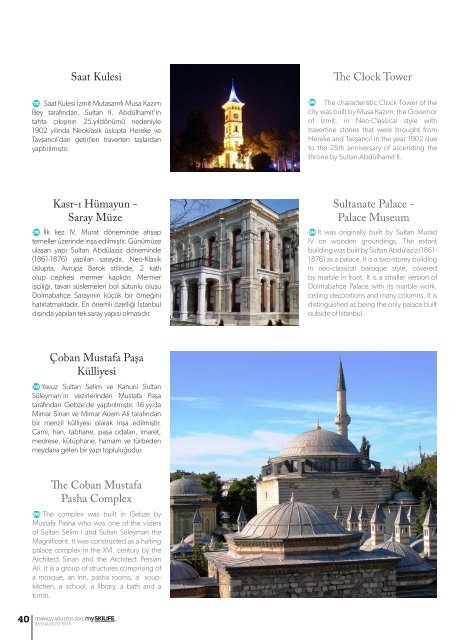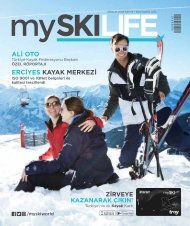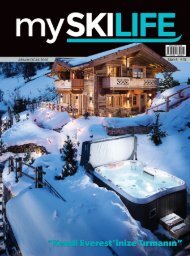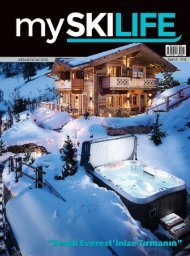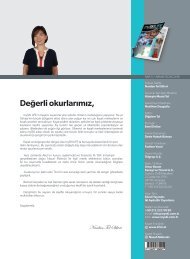"Alp Esintisi"
mySKI LIFE ISSUE:3 - JULY/AUGUST 2015
mySKI LIFE ISSUE:3 - JULY/AUGUST 2015
- No tags were found...
You also want an ePaper? Increase the reach of your titles
YUMPU automatically turns print PDFs into web optimized ePapers that Google loves.
Saat Kulesi<br />
Saat Kulesi İzmit Mutasarrıfı Musa Kazım<br />
Bey tarafından, Sultan II. Abdülhamit’in<br />
tahta çıkışının 25.yıldönümü nedeniyle<br />
1902 yılında Neoklasik üslupta Hereke ve<br />
Tavşancıl’dan getirilen traverten taşlardan<br />
yaptırılmıştır.<br />
Kasr-ı Hümayun -<br />
Saray Müze<br />
İlk kez IV. Murat döneminde ahşap<br />
temeller üzerinde inşa edilmiştir. Günümüze<br />
ulaşan yapı Sultan Abdülaziz döneminde<br />
(1861-1876) yapılan saraydır. Neo-Klasik<br />
üslupta, Avrupa Barok stilinde, 2 katlı<br />
olup cephesi mermer kaplıdır. Mermer<br />
işçiliği, tavan süslemeleri bol sütunlu oluşu<br />
Dolmabahçe Sarayının küçük bir örneğini<br />
hatırlatmaktadır. En önemli özelliği İstanbul<br />
dışında yapılan tek saray yapısı olmasıdır.<br />
Çoban Mustafa Paşa<br />
Külliyesi<br />
Yavuz Sultan Selim ve Kanuni Sultan<br />
Süleyman’ın vezirlerinden Mustafa Paşa<br />
tarafından Gebze’de yaptırılmıştır. 16.yy.da<br />
Mimar Sinan ve Mimar Acem Ali tarafından<br />
bir menzil külliyesi olarak inşa edilmiştir.<br />
Cami, han, tabhane, paşa odaları, imaret,<br />
medrese, kütüphane, hamam ve türbeden<br />
meydana gelen bir yapı topluluğudur.<br />
The Clock Tower<br />
The characteristic Clock Tower of the<br />
city was built by Musa Kazım, the Governor<br />
of İzmit, in Neo-Classical style with<br />
travertine stones that were brought from<br />
Hereke and Tavşancıl in the year 1902 due<br />
to the 25th anniversary of ascending the<br />
throne by Sultan Abdülhamit II.<br />
Sultanate Palace -<br />
Palace Museum<br />
It was originally built by Sultan Murad<br />
IV on wooden groundings. The extant<br />
building was built by Sultan Abdülaziz (1861-<br />
1876) as a palace. It is a two-storey building<br />
in neo-classical baroque style, covered<br />
by marble in front. It is a smaller version of<br />
Dolmabahçe Palace with its marble work,<br />
ceiling decorations and many columns. It is<br />
distinguished as being the only palace built<br />
outside of Istanbul.<br />
Kocaeli Arkeoloji ve<br />
Etnoğrafya Müzesi<br />
Eski Gar Binası, Kocaeli Kültür ve<br />
Tabiat Varlıklarını Koruma Bölge Kurulu<br />
olarak hizmet vermektedir. Arkeoloji ve<br />
Etnoğrafya Müzesi olarak hizmet veren alan<br />
içinde bir tamir atölyesi, bir su deposu ve<br />
bir lojman binası yer almaktadır. İki adet<br />
Tekel Deposu birleştirilerek (Arkeolojik<br />
ve Etnografik eserler için) teşhir salonları<br />
oluşturulmuştur. Arkeoloji ve Etnoğrafya<br />
Müzesinde Paleolitik, Helenistik, Roma,<br />
Bizans ve Osmanlı dönemlerine ait eserler<br />
sergilenmektedir.<br />
Atatürk ve Redif Müzesi<br />
İzmit’in son dönem Osmanlı’da<br />
Redif Subayları için yapılmış askeri<br />
yapılarından olan Redif Dairesinin iç<br />
mekân tavanları 19. yüzyıl kalemişi<br />
bezemeleri ile süslenmiştir. 17<br />
Ağustos 1999 depreminden önce<br />
Askeri Mahkeme olarak kullanılan<br />
bina depremde hasar görmüş ve içi<br />
boşaltılmıştır. Kocaeli Valiliği İl Özel<br />
İdaresi tarafından yenileme çalışmaları<br />
tamamlanarak Atatürk ve Redif Müzesi<br />
olarak ziyarete açılmıştır.<br />
Pertev Paşa Külliyesi<br />
Külliye 16.yy.’da Mimar Sinan tarafından<br />
yapılmıştır. Bugün Yeni Cuma Camii<br />
adıyla anılmaktadır. Cami çeşme, hamam,<br />
medrese, kervansaray ve aşhaneden<br />
meydana gelmiştir.<br />
Archeology and Etnography<br />
Museum of Kocaeli<br />
Historical Railway Station building<br />
provides service as the Protection of Cultural<br />
Properties District Office of Kocaeli. The<br />
space that furnishes service as Museum of<br />
Archeology-Etnography which encloses<br />
a repair shop, a water tank and lodging<br />
building. The two Monopoly buildings were<br />
joined together in order to form show rooms<br />
for the archeological and ethnographical<br />
heritage. Artworks of Paleolithic, Hellenistic,<br />
Roman, Byzantine and Ottoman periods are<br />
displayed in the Museum of Archeology-<br />
Etnography.<br />
Atatürk and Redif Museum<br />
The building that is belong to Late<br />
Ottoman Period was constructed in the<br />
second Empire style as being semi masonry<br />
barracks type. Indoor ceilings of the Reserve<br />
Army Office, which was built for the reserve<br />
officers in the last Ottoman period, are<br />
decorated with hand-drawn ornaments.<br />
The building was used as a Martial Court<br />
before the earthquake of 17th August<br />
1999. It was damaged in the earthquake<br />
and evacuated. It was opened to visit as<br />
Atatürk and Redif (Reserve Army Office)<br />
Museum after having been reconstructed<br />
by Kocaeli Governorship Special Provincial<br />
Administration.<br />
The Pertev Pasha Complex<br />
The complex was built by the Architect<br />
Sinan in the XVI. century. Today it is called<br />
“Yeni Cuma Camii” (The New Friday<br />
Mosque).The complex was comprised of<br />
a mosque, a fountain, baths, a school, a<br />
caravansary and a soup kitchen.<br />
The Coban Mustafa<br />
Pasha Complex<br />
The complex was built in Gebze by<br />
Mustafa Pasha who was one of the viziers<br />
of Sultan Selim I and Sultan Suleyman the<br />
Magnificent. It was constructed as a halting<br />
palace complex in the XVI. century by the<br />
Architect Sinan and the Architect Persian<br />
Ali. It is a group of structures comprising of<br />
a mosque, an inn, pasha rooms, a soupkitchen,<br />
a school, a library, a bath and a<br />
tomb.<br />
Hannibal’ın Anıtı-<br />
Gebze<br />
Hannibal, Roma yenilgisinden sonra<br />
Kartaca’yı terk ederek Bitinya Kralı Prussias’ın<br />
yanına sığınmış, Libyssa (Gebze)’de intihar<br />
ederek yaşamına son vermiştir. Gebze’de<br />
Hannibal’in mezarı olarak bilinen bu yerde<br />
bir anıt yapılması ilk kez 1934 yılında Atatürk<br />
tarafından emredilmiştir. Bu emir 1981 yılında<br />
Kültür Bakanlığınca gerçekleştirilmiştir.<br />
Hannibal’s Memorial-<br />
Gebze<br />
Hannibal left Kartaca (Carthagia) after<br />
the Roman’s defeat and took refuge with<br />
the Bithinian King, Prussias. He commited<br />
suicide in Libyssa (Gebze) and claimed<br />
his life. A memorial was first ordered to be<br />
built by Atatürk’s in 1934 in Gebze which<br />
is believed to be Hannibal’s resting place,<br />
however that order was only fullfilled in<br />
1981 by the Ministry of Culture.<br />
TEMMUZ/AĞUSTOS 2015<br />
TEMMUZ/AĞUSTOS 2015<br />
40 JULY/AUGUST 2015 JULY/AUGUST 2015<br />
41


